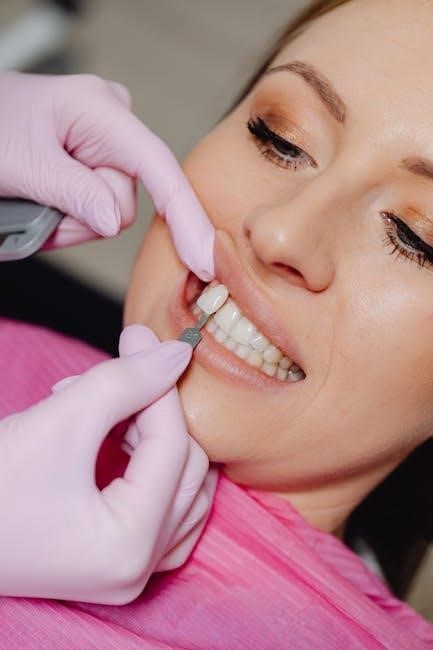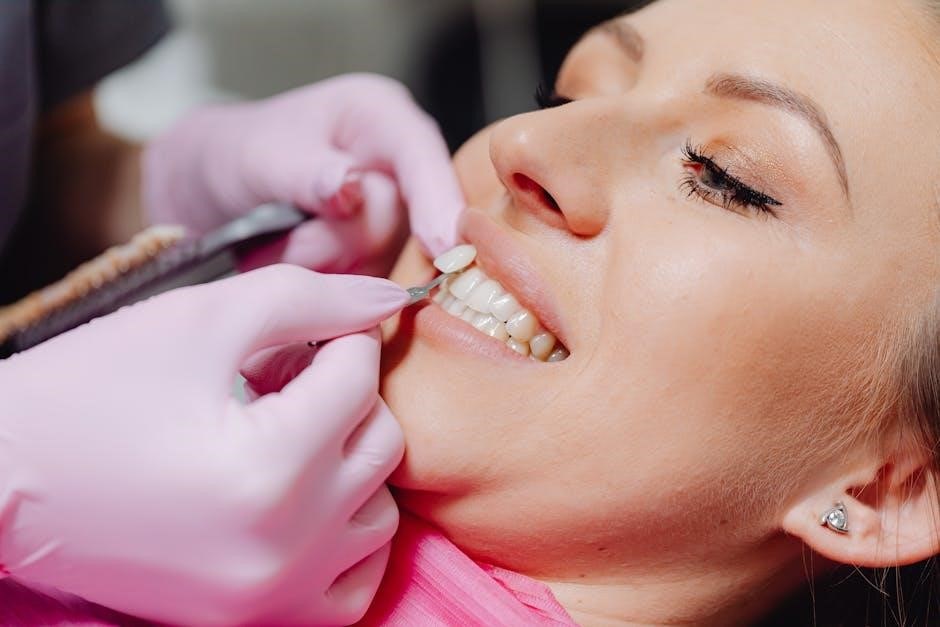A teeth whitening shade guide is a valuable tool for determining your current tooth color and selecting the desired shade, helping achieve a brighter, more radiant smile effectively.
Understanding the Importance of Shade Guides in Teeth Whitening
Shade guides are essential for assessing and communicating tooth color effectively. They help dentists and patients determine the current shade and set realistic expectations for the desired outcome. By providing a standardized reference, shade guides ensure consistency in treatment planning and monitoring progress. This tool is vital for achieving satisfying results, as it helps avoid over-whitening or under-whitening. Shade guides also aid in maintaining patient satisfaction by ensuring the final result aligns with their goals. Their role extends to both in-office and at-home treatments, making them a cornerstone in modern teeth whitening practices.

How Teeth Whitening Shade Guides Work
Shade guides use standardized charts to match current tooth color and determine target shades. They help monitor progress and ensure accurate, desired results for whitening treatments.
Matching Current Tooth Color and Determining Target Shade
Dentists use shade guides to assess tooth color accurately, ensuring treatments align with desired results. By comparing teeth to the guide, professionals identify the current shade and set realistic goals. This process involves evaluating tooth color variables like value (lightness/darkness), hue (actual color), and chroma (intensity). Patients can also visually track progress, ensuring satisfaction. Personal preferences, skin tone, and hair color are considered to achieve a natural, harmonious smile. This step is crucial for creating a customized whitening plan and monitoring improvements effectively throughout the treatment journey.
Types of Teeth Whitening Shade Guides
Shade guides are categorized into universal and customized types. Universal guides offer standard shade ranges, while customized guides are tailored to individual tooth color variations for precise matching.
Universal vs. Customized Shade Guides
Universal shade guides are standard tools used by most dental professionals, offering a fixed range of shades to cater to the majority of patients. These guides are cost-effective and widely available, making them a common choice for initial consultations. On the other hand, customized shade guides are tailored to individual tooth color variations, providing more precise and personalized results. They often incorporate advanced features like adjustable hue, value, and chroma to match unique tooth characteristics. While universal guides are practical, customized options ensure a more accurate and aesthetically pleasing outcome, especially for complex cases or high-end cosmetic treatments.

Factors Influencing Tooth Color and Shade
Tooth color and shade are influenced by enamel thickness, dentin color, and staining factors, which can cause variations in tooth appearance and affect whitening outcomes.
Enamel, Dentin, and Staining Factors
Tooth color is significantly influenced by the thickness of enamel, the underlying dentin color, and the presence of stains. Enamel, the outer layer, varies in thickness, affecting tooth brightness. Thinner enamel allows dentin’s natural yellowish hue to show through. Staining, categorized as intrinsic or extrinsic, further impacts shade. Intrinsic stains, deep within the tooth, result from aging, trauma, or medication. Extrinsic stains, on the enamel surface, are caused by coffee, tobacco, or poor hygiene. These factors determine tooth color variation and influence the effectiveness of whitening treatments, as some stains respond better to specific methods than others.

Choosing the Right Target Shade
Selecting the ideal shade involves considering natural tooth color, skin tone, and hair color to ensure a harmonious, aesthetically pleasing smile that looks natural and radiant.
Considering Natural Tooth Color, Skin Tone, and Hair Color
When selecting a target shade, it’s essential to consider your natural tooth color, skin tone, and hair color for a cohesive look. Lighter skin tones often complement whiter shades, while warmer skin tones may suit slightly yellower shades. Hair color also plays a role, with darker hair contrasting well with brighter teeth. Your dentist will help match these factors to ensure your smile appears natural and harmonious. Additionally, maintaining your results through touch-ups and proper care will keep your teeth looking their best over time.
The Role of Shade Guides in Measuring Whitening Progress
Shade guides are essential for tracking teeth whitening progress by comparing before-and-after results, ensuring treatments are effective and achieving the desired color improvement efficiently.
Before-and-After Comparisons for Treatment Evaluation
Shade guides play a crucial role in evaluating the effectiveness of teeth whitening treatments by providing clear before-and-after comparisons. Dentists use these tools to measure the visible improvement in tooth color, ensuring that the desired results are achieved. By comparing the initial shade to the post-treatment shade, professionals can assess the success of the procedure and make necessary adjustments. This visual documentation also helps patients see the progress, boosting their satisfaction and confidence in the treatment. Regular use of shade guides ensures accurate and consistent monitoring, making them indispensable for both in-office and at-home whitening treatments.

Versatility of Shade Guides
Shade guides are versatile tools used in both in-office and at-home whitening treatments, ensuring consistent and accurate color matching for personalized smile enhancement and monitoring progress effectively.
Application in Both In-Office and At-Home Whitening Treatments
Shade guides play a pivotal role in both professional and home-based whitening procedures. In-office treatments utilize these tools to ensure precise color matching and monitor progress effectively. For at-home kits, guides help users track their whitening journey, offering a clear visual reference to measure changes over time. This dual applicability makes shade guides indispensable for achieving consistent results across different treatment settings, ensuring patients can maintain their desired smile effortlessly. Whether in a clinical environment or personal care, shade guides provide a reliable method to assess and achieve optimal tooth whitening outcomes, enhancing both convenience and effectiveness for users.
Understanding Tooth Color Science
Tooth color science involves analyzing value (lightness), hue (color tone), and chroma (saturation) to determine shades accurately, crucial for effective teeth whitening and shade matching processes.
Value, Hue, and Chroma in Shade Selection
Tooth color science is based on three key components: value, hue, and chroma. Value refers to the lightness or darkness of a tooth, ranging from bright white to deep shades. Hue denotes the actual color tone, such as yellow, brown, or gray. Chroma indicates the intensity or saturation of the color. Understanding these elements helps dentists and patients select the most natural-looking shade during teeth whitening. Shade guides are organized by these variables, making it easier to match current tooth color and determine the target shade for a harmonious, aesthetically pleasing smile.
Maintenance and Touch-Ups Using Shade Guides
Shade guides help monitor whitening results and schedule follow-ups. They ensure consistency, preventing over-whitening, and maintain desired shade over time for a lasting, radiant smile.
Monitoring Results and Scheduling Follow-Up Treatments
Shade guides are essential for tracking progress during and after teeth whitening treatments. By comparing the current shade with the target shade, patients and dentists can evaluate effectiveness. This tool helps identify how many shades lighter the teeth have become, ensuring realistic expectations are met. Regular monitoring also allows for adjustments in treatment plans if additional whitening is needed. Follow-up appointments are scheduled based on the shade guide to maintain results and prevent rebound staining. This consistent approach ensures long-term satisfaction and a radiant smile, making shade guides indispensable for both initial and ongoing care.
Future Trends in Teeth Whitening Shade Guides
Future trends include advanced digital tools and AI for precise shade matching, offering personalized solutions and enhancing treatment outcomes significantly.
Digital and Customized Shade Matching Technologies
Digital and customized shade matching technologies are revolutionizing teeth whitening by providing precise, personalized solutions. Advanced tools like AI-powered shade analyzers and 3D modeling enable real-time, accurate color matching, reducing human error. These technologies allow dentists to create tailored treatment plans, ensuring natural-looking results. Customized guides adapt to individual tooth characteristics, offering a more efficient and satisfying experience. Digital solutions also facilitate better communication between patients and professionals, making the whitening process more transparent and effective. As these technologies evolve, they promise to set new standards in achieving desired shades with minimal effort and maximum precision.

